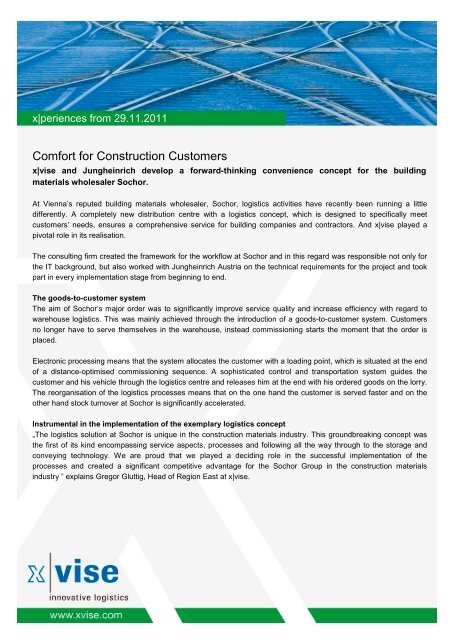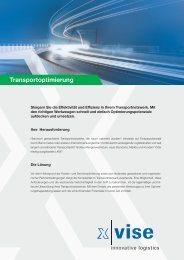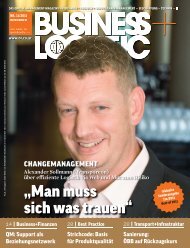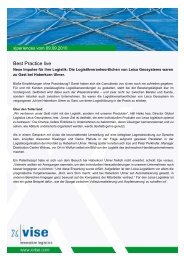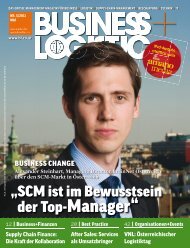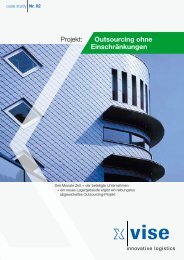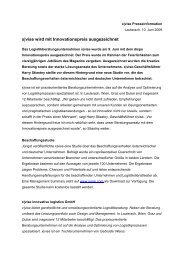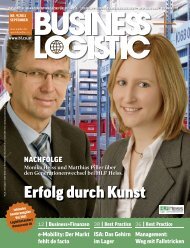Comfort for Construction Customers
Comfort for Construction Customers
Comfort for Construction Customers
Create successful ePaper yourself
Turn your PDF publications into a flip-book with our unique Google optimized e-Paper software.
x|periences from 29.11.2011<br />
<strong>Com<strong>for</strong>t</strong> <strong>for</strong> <strong>Construction</strong> <strong>Customers</strong><br />
x|vise and Jungheinrich develop a <strong>for</strong>ward-thinking convenience concept <strong>for</strong> the building<br />
materials wholesaler Sochor.<br />
At Vienna’s reputed building materials wholesaler, Sochor, logistics activities have recently been running a little<br />
differently. A completely new distribution centre with a logistics concept, which is designed to specifically meet<br />
customers’ needs, ensures a comprehensive service <strong>for</strong> building companies and contractors. And x|vise played a<br />
pivotal role in its realisation.<br />
The consulting firm created the framework <strong>for</strong> the workflow at Sochor and in this regard was responsible not only <strong>for</strong><br />
the IT background, but also worked with Jungheinrich Austria on the technical requirements <strong>for</strong> the project and took<br />
part in every implementation stage from beginning to end.<br />
The goods-to-customer system<br />
The aim of Sochor’s major order was to significantly improve service quality and increase efficiency with regard to<br />
warehouse logistics. This was mainly achieved through the introduction of a goods-to-customer system. <strong>Customers</strong><br />
no longer have to serve themselves in the warehouse, instead commissioning starts the moment that the order is<br />
placed.<br />
Electronic processing means that the system allocates the customer with a loading point, which is situated at the end<br />
of a distance-optimised commissioning sequence. A sophisticated control and transportation system guides the<br />
customer and his vehicle through the logistics centre and releases him at the end with his ordered goods on the lorry.<br />
The reorganisation of the logistics processes means that on the one hand the customer is served faster and on the<br />
other hand stock turnover at Sochor is significantly accelerated.<br />
Instrumental in the implementation of the exemplary logistics concept<br />
„The logistics solution at Sochor is unique in the construction materials industry. This groundbreaking concept was<br />
the first of its kind encompassing service aspects, processes and following all the way through to the storage and<br />
conveying technology. We are proud that we played a deciding role in the successful implementation of the<br />
processes and created a significant competitive advantage <strong>for</strong> the Sochor Group in the construction materials<br />
industry ” explains Gregor Gluttig, Head of Region East at x|vise.
x|periences from 29.11.2011<br />
Logistics as Leverage <strong>for</strong> Liquidity and Profitability<br />
Increased pressure on margins, disappointing cash-flow development in times of crisis or lack of<br />
capital <strong>for</strong> growth investment. These issues are more topical than ever. With a comprehensive<br />
working capital management program, as a logistics specialist you can significantly improve the<br />
financial clout of your company and equip yourself <strong>for</strong> future growth.<br />
Let us first take a look at the text books! If we add the days of inventory outstanding to the days of sales outstanding<br />
and subtract the days of payables outstanding, the result is the so-called duration of capital tie-up (see diagram). If<br />
we take this <strong>for</strong>mula into consideration, then the relation between financial management and logistics becomes clear.<br />
If finance primarily manages the payment periods, then the days of inventory outstanding is predominantly the<br />
responsibility of the logistics specialist. If both of them pull together, then capital can be released or liquidity created.<br />
Working Capital along Supply Chain<br />
Feedstock<br />
purchase<br />
Feedstock<br />
delievery<br />
and<br />
payment<br />
DPO 1)<br />
Pay<br />
feedstock<br />
payment<br />
Customer<br />
order<br />
Start<br />
fabrication<br />
Inventory outstanding (DIO 3) )<br />
1) DPO = Days payables outstanding<br />
2) DSO = Days sales outstanding<br />
3) DIO = Days inventory outstanding<br />
Source: Schulz & Partner „Rentabilitäts- und Working Capital Analyse 2011“<br />
Finish<br />
fabrication<br />
Delivery and<br />
invoice<br />
Expected<br />
incoming<br />
payment<br />
Customer<br />
pay the bill<br />
Customer (debtors; DSO 2) )<br />
Capital commitment = DIO + DSO - DPO<br />
Really<br />
incoming<br />
payment
x|periences from 29.11.2011<br />
In this context, it is worth taking a look at Roland Berger and Creditre<strong>for</strong>m’s current study „Cash 4 Growth“, which<br />
shows significant differences in the duration of capital tie-up depending on the size of the company and type of<br />
industry. Hence, larger companies have a significantly shorter duration of capital tie-up. Some of the reasons <strong>for</strong> this<br />
are that larger companies have more success in negotiating their payment terms compared with smaller companies.<br />
Furthermore, the target of low working capital has a higher weighting in larger companies and is more highly sought<br />
after. Thus companies with a turnover of up to €10m register a duration of capital tie-up of approx. 60 days. Large<br />
companies, however, with a turnover exceeding €200m have tie-ups of less than 45 days.<br />
More important <strong>for</strong> logistics specialists is the consideration of the results of the study according to the type of<br />
industry. The best working capital per<strong>for</strong>mance can be found in telecommunications (19 days), trade (43 days) and<br />
IT. Industries in which capital is tied-up <strong>for</strong> the longest periods are textiles (90 days), pharmaceuticals and<br />
engineering (79 days). The difference here is mainly with regard to stocks.<br />
Levers <strong>for</strong> a reduction of stocks or inventories can be found, <strong>for</strong> example, in production optimisation in order to<br />
minimise throughput times and buffer stock. Further potential can be seen in warehousing where safety stocks can<br />
be scrutinised and slow-movers can be cleared, or by redesigning the warehousing concept, <strong>for</strong> example through a<br />
VMI concept, direct deliveries or order-related production. The standardisation of parts and processes also provides<br />
further leverage <strong>for</strong> improving stock management.<br />
Another important aspect is the improvement of networking in the supply chain with the aim of reducing the build up<br />
of inventories in terms of the whiplash effect. There<strong>for</strong>e, communication between suppliers, manufacturers, logistics<br />
service providers and customers needs to be improved. Catchword ECR: it is no coincidence that trade is the topranking<br />
industry with regard to duration of capital tie-up. In addition to IT integration and harmonisation, joint ventures<br />
and partnerships can also help to improve networking and thus communication throughout the supply chain.<br />
Working capital is one of the main levers <strong>for</strong> improving liquidity. With strict management of your working capital you<br />
can overcome the diverse challenges yourself, without the need <strong>for</strong> expensive external finance from banks. Only<br />
those who have all the parameters in place can secure liquidity and profitability, thus ensuring the long-term success<br />
of the company!


